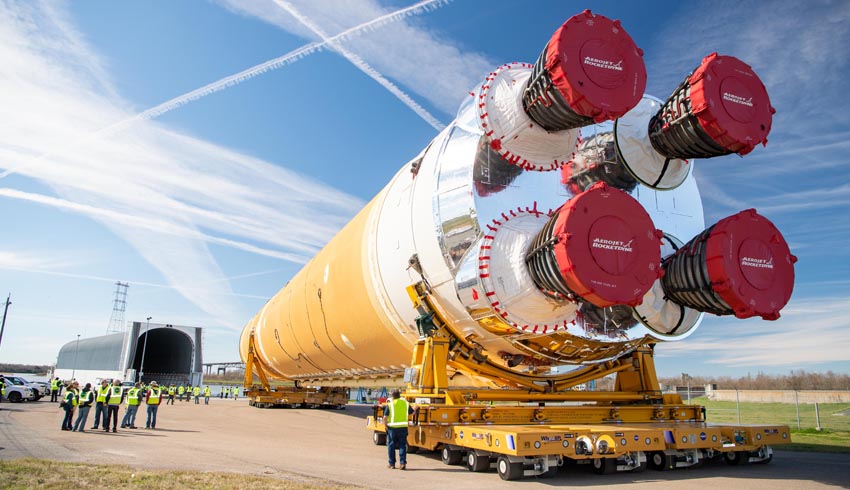The roughly 1.3-mile trip from the Michoud factory to the barge’s dock is just the start of the SLS flight hardware’s journey. Pegasus will ferry the SLS core stage from Michoud to Stennis, where the core stage will be lifted and placed into the historic B-2 Test Stand for the core stage Green Run test campaign that will begin later this year.
NASA deputy administrator Jim Morhard said, "NASA’s Space Launch System core stage is part of the Artemis program, which is a national asset."
The Green Run series is a comprehensive test campaign of the stage — from its avionics and propulsion systems to its four RS-25 engines — that will verify the core stage design ready for launch.
"The SLS rocket was built to deliver American astronauts and maximum payloads to the moon and deep space destinations. Rolling out the completed core stage from NASA’s Michoud Assembly Facility to go on to NASA’s Stennis Space Center for further testing is an exciting leap forward in the Artemis program as NASA teams make progress toward the launch pad," Morhard added.
Before launching NASA’s Orion spacecraft to the moon, the SLS rocket stage will take the same water route that the first stages of the Saturn V rocket did when it was transported from Michoud to Stennis for testing during the Apollo Program in the 1960s and 1970s.
Pegasus, which previously ferried the space shuttle tanks from Michoud to NASA’s Kennedy Space Center in Florida, was modified to make it longer and stronger to accommodate the core stage and ferry the SLS rocket hardware.
Following Green Run, the barge will carry the core stage flight hardware to Kennedy for launch preparations.
John Honeycutt, the SLS program manager at NASA’s Marshall Space Flight Center in Huntsville, Alabama, welcomed the milestone, "Completion of this first-time build of the Space Launch System rocket’s core stages puts humans on the cusp of a new era of space exploration."
The SLS rocket’s core stage is the largest stage NASA has ever built at its Louisiana factory, including the Saturn V rocket stages for the agency’s first moon missions.
Honeycutt added, "NASA’s SLS rocket is designed to evolve so a variety of missions can be accomplished first to the Moon for the Artemis missions and then to Mars and other deep space destinations."
With a design featuring some of the most sophisticated hardware ever built for spaceflight, the core stage is the powerhouse of the SLS rocket. In addition to its miles of complex cabling, avionics and propulsion systems, its two propellant tanks hold a combined 733,000 gallons of propellant to power the four RS-25 engines.
Manufacturing the SLS rocket’s core stages is a combined effort for NASA and its industry partners. More than 1,100 companies across the US contributed towards the production of the SLS rocket. Boeing built the core stage at NASA’s facility in New Orleans, and Aerojet Rocketdyne upgraded and supplied the RS-25 engines.
Teams at Michoud are working in tandem to manufacture and assemble core stages for the first three Artemis lunar missions.
With the assembly of the core stage for Artemis I complete, NASA is focusing its efforts on building the core stages for Artemis II, the first crewed mission of SLS and NASA’s Orion spacecraft, and Artemis III, the mission that will send American astronauts to the lunar South Pole.
In addition to the progress of the SLS rocket in 2019, NASA and its partners completed production of NASA’s Orion spacecraft. The spacecraft is undergoing final testing at NASA’s Plum Brook Station in Ohio.
Julie Bassler, the NASA SLS Stages manager added, "This is a historic moment for NASA’s Artemis program and a proud time for the Space Launch System Core Stage team as the first flight article leaves the factory floor."
NASA’s Exploration Ground Systems at Kennedy has verified the launch pad’s infrastructure and sound suppression system for the first Artemis launch.
"Roll out of the core stage to Stennis ahead of the core stage Green Run test series signals an exciting next phase as NASA prepares for the first Artemis launch. The Green Run test series will verify the stage is ready to ship to the launch site," Bassler said.
Kennedy’s launch team held its first formal training simulation, while flight controllers at NASA’s Johnson Space Center in Houston conducted a similar simulation training for Orion’s uncrewed flight to the moon.
NASA is working to land the first woman and the next man on the moon by 2024. SLS, along with Orion and the Gateway in orbit around the moon, are NASA’s backbone for deep space exploration. SLS is the only rocket that can send Orion, astronauts and supplies to the moon on a single mission.

